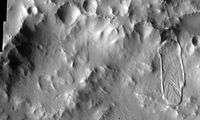Montevallo (crater)
|
Montevallo Crater, as seen by THEMIS. Image shows a landslide on the north rim. | |
| Planet | Mars |
|---|---|
| Coordinates | 15°24′N 54°24′W / 15.4°N 54.4°WCoordinates: 15°24′N 54°24′W / 15.4°N 54.4°W |
| Diameter | 51.9 km |
| Eponym | Montevallo, Alabama, USA |
Montevallo Crater is a crater in the Lunae Palus quadrangle of Mars, located at 15.4° N and 54.4° W. It is 51.9 km in diameter and was named after the town Montevallo, Alabama, USA.[1] Impact craters generally have a rim with ejecta around them, in contrast volcanic craters usually do not have a rim or ejecta deposits. As craters get larger (greater than 10 km in diameter) they usually have a central peak.[2] The peak is caused by a rebound of the crater floor following the impact.[3]
 Montevallo Crater, as seen by CTX camera (on Mars Reconnaissance Orbiter).
Montevallo Crater, as seen by CTX camera (on Mars Reconnaissance Orbiter).
Why are Craters important?
The density of impact craters is used to determine the surface ages of Mars and other solar system bodies.[2] The older the surface, the more craters present. Crater shapes can reveal the presence of ground ice.
The area around craters may be rich in minerals. On Mars, heat from the impact melts ice in the ground. Water from the melting ice dissolves minerals, and then deposits them in cracks or faults that were produced with the impact. This process, called hydrothermal alteration, is a major way in which ore deposits are produced. The area around Martian craters may be rich in useful ores for the future colonization of Mars.[4]
See also
References
- ↑ http://planetarynames.wr.usgs.gov/
- 1 2 http://www.lpi.usra.edu/publications/slidesets/stones/
- ↑ Hugh H. Kieffer (1992). Mars. University of Arizona Press. ISBN 978-0-8165-1257-7. Retrieved 7 March 2011.
- ↑ http://www.indiana.edu/~sierra/papers/2003/Patterson.html.
